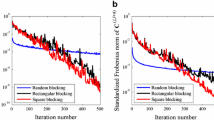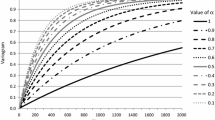Abstract
The likelihood of Gaussian realizations, as generated by the Cholesky simulation method, is analyzed in terms of Mahalanobis distances and fluctuations in the variogram reproduction. For random sampling, the probability to observe a Gaussian realization vector can be expressed as a function of its Mahalanobis distance, and the maximum likelihood depends only on the vector size. The Mahalanobis distances are themselves distributed as a Chi-square distribution and they can be used to describe the likelihood of Gaussian realizations. Their expected value and variance are only determined by the size of the vector of independent random normal scores used to generate the realizations. When the vector size is small, the distribution of Mahalanobis distances is highly skewed and most realizations are close to the vector mean in agreement with the multi-Gaussian density model. As the vector size increases, the realizations sample a region increasingly far out on the tail of the multi-Gaussian distribution, due to the large increase in the size of the uncertainty space largely compensating for the low probability density. For a large vector size, realizations close to the vector mean are not observed anymore. Instead, Gaussian vectors with Mahalanobis distance in the neighborhood of the expected Mahalanobis distance have the maximum probability to be observed. The distribution of Mahalanobis distances becomes Gaussian shaped and the bulk of realizations appear more equiprobable. However, the ratio of their probabilities indicates that they still remain far from being equiprobable. On the other hand, it is observed that equiprobable realizations still display important fluctuations in their variogram reproduction. The variance level that is expected in the variogram reproduction, as well as the variance of the variogram fluctuations, is dependent on the Mahalanobis distance. Realizations with smaller Mahalanobis distances are, on average, smoother than realizations with larger Mahalanobis distances. Poor ergodic conditions tend to generate higher proportions of flatter variograms relative to the variogram model. Only equiprobable realizations with a Mahalanobis distance equal to the expected Mahalanobis distance have an expected variogram matching the variogram model. For large vector sizes, Cholesky simulated Gaussian vectors cannot be used to explore uncertainty in the neighborhood of the vector mean. Instead uncertainty is explored around the n-dimensional elliptical envelop corresponding to the expected Mahalanobis distance.













Similar content being viewed by others
References
Alabert F (1987) The practice of fast conditional simulations through the LU decomposition of the covariance matrix. Math Geol 19(5):369–386
Caers J (2005) Petroleum geostatistics. Society of Petroleum Engineers, Richardson, 104 pp
Chiles JP, Delfiner P (1999) Geostatistics modeling spatial uncertainty. Wiley series in probability and statistics. Wiley, New York, 695 pp
Davis MW (1987) Product of conditional simulations via the LU triangular decomposition of the covariance matrix. Math Geol 19(2):91–98
Deutsch CV (2002) Geostatistical reservoir modeling. Oxford University Press, London, 376 pp
Deutsch CV, Journel AG (1998) GSLIB geostatistical software library and user’s guide, 2nd edn. Oxford University Press, London, 369 pp
Dowd PA, Sarac C (1994) An extension of the LU decomposition method of simulation. In: Armstrong M, Dowd PA (eds) Geostatistical simulations. Kluwer Academic, Dordrecht, pp 23–36
Goovaerts P (1997) Geostatistics for natural resources evaluation. Oxford University Press, London, 483 pp
Hu Ly, Le Ravalec-Dupin M (2004) On some controversial issues of geostatistical simulation. In: Leuangthong O, Deutsch CV (eds) Geostatistics Banff 2004. Springer, Berlin, pp 175–184.
Isaaks EH, Srivastava RM (1989) An introduction to applied geostatistics. Oxford University Press, London, 561 pp
James F (1990) A review of pseudorandom number generators. Comput Phys Commun 60:329–344
Leuangthong O, McLennan JA, Deutsch CV (2004) Minimum acceptance criteria for geostatistical realizations. Nat Resour Res 13(3):131–141
Oliver DS, Reynolds AC, Ning L (2008) Inverse theory for petroleum reservoir characterization and history matching. Cambridge University Press, Cambridge, 380 pp
Pearson K (1900) On the criterion that a given system of deviations from the probable in the case of a correlated system of variables is such that can be reasonably supposed to have arisen from random sampling. Philos Mag 50:157–175
Ross MR (1989) Introduction to probability models, 4th edn. Academic Press, San Diego, 544 pp
Sykora S (ed) (2005) Surface integrals over n-dimensional spheres, vol. I. Permalink via doi:10.3247/SL1Math05.002, http://www.ebyte.it/library/docs/math05a/nDimSphereSurfaces05.html. Accessed 28 Aug 2012
Tarantola A (2005) Inverse problem theory and methods for model parameter estimation. SIAM, Philadelphia, 342 pp
Vargas-Guzman JA, Dimitrakopoulos R (2002) Conditional simulation of random fields by successive residuals. Math Geol 34(5):597–611
Acknowledgements
Acknowledgements are given to Dr. Allan Hiebert and Computer Modelling Group Ltd. for their support. Special thanks to Kristine Griba for reviewing the English syntax and grammar. Comments and discussions from reviewers, assistant-editor, and the chief-editor have greatly helped to improve the final version of this paper.
Author information
Authors and Affiliations
Corresponding author
Rights and permissions
About this article
Cite this article
Bourgault, G. On the Likelihood and Fluctuations of Gaussian Realizations. Math Geosci 44, 1005–1037 (2012). https://doi.org/10.1007/s11004-012-9424-3
Received:
Accepted:
Published:
Issue Date:
DOI: https://doi.org/10.1007/s11004-012-9424-3




